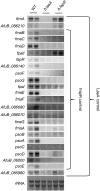Prototype of an intertwined secondary-metabolite supercluster
- PMID: 24082142
- PMCID: PMC3801025
- DOI: 10.1073/pnas.1313258110
Prototype of an intertwined secondary-metabolite supercluster
Abstract
The hallmark trait of fungal secondary-metabolite gene clusters is well established, consisting of contiguous enzymatic and often regulatory gene(s) devoted to the production of a metabolite of a specific chemical class. Unexpectedly, we have found a deviation from this motif in a subtelomeric region of Aspergillus fumigatus. This region, under the control of the master regulator of secondary metabolism, LaeA, contains, in its entirety, the genetic machinery for three natural products (fumitremorgin, fumagillin, and pseurotin), where genes for fumagillin and pseurotin are physically intertwined in a single supercluster. Deletions of 29 adjoining genes revealed that fumagillin and pseurotin are coregulated by the supercluster-embedded regulatory gene with biosynthetic genes belonging to one of the two metabolic pathways in a noncontiguous manner. Comparative genomics indicates the fumagillin/pseurotin supercluster is maintained in a rapidly evolving region of diverse fungal genomes. This blended design confounds predictions from established secondary-metabolite cluster search algorithms and provides an expanded view of natural product evolution.
Keywords: FapR; Zn(II)2Cys6 transcription factor; biosynthesis; cluster evolution; gene regulation.
Conflict of interest statement
The authors declare no conflict of interest.
Figures




Comment in
-
Supercluster takes a walk on the wild side.Trends Microbiol. 2013 Dec;21(12):617-8. doi: 10.1016/j.tim.2013.11.002. Epub 2013 Nov 14. Trends Microbiol. 2013. PMID: 24239205
References
-
- Hoffmeister D, Keller NP. Natural products of filamentous fungi: Enzymes, genes, and their regulation. Nat Prod Rep. 2007;24(2):393–416. - PubMed
-
- Brakhage AA. Regulation of fungal secondary metabolism. Nat Rev Microbiol. 2013;11(1):21–32. - PubMed
-
- Rohlfs M, Churchill AC. Fungal secondary metabolites as modulators of interactions with insects and other arthropods. Fungal Genet Biol. 2011;48(1):23–34. - PubMed
Publication types
MeSH terms
Substances
Grants and funding
LinkOut - more resources
Full Text Sources
Other Literature Sources
Molecular Biology Databases

